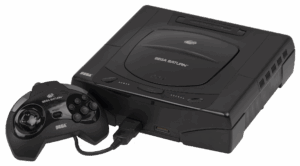
The Sega Saturn was a 32-bit fifth-generation home video game console released by Sega in Japan in November 1994, and in North America and Europe in 1995. Despite its advanced arcade-quality hardware, its complex architecture, a disastrous US launch, and overwhelming competition from the Sony PlayStation and Nintendo 64 ultimately led to its failure in Western markets. However, the console achieved more success in Japan and is celebrated by fans for its stellar library of 2D titles, fighting games, and unique exclusives.
Technical specifications
The Saturn’s hardware was an amalgamation of multiple processors, a design intended to handle both the 2D games it was known for and the burgeoning 3D market.
- Dual CPUs: The system featured two 32-bit Hitachi SH-2 central processing units running in parallel, a powerful but notoriously difficult architecture for developers to work with.
- Two video processors (VDP): One video display processor (VDP1) was dedicated to rendering sprites and polygons, while another (VDP2) was for backgrounds and special effects. This design made the Saturn exceptionally good at 2D graphics but less efficient for 3D compared to the PlayStation.
- Sound: A Yamaha sound processor provided 32 channels of audio, supporting both PCM sampling and FM synthesis.
- Media: Games were released on CD-ROMs, and the console also included a cartridge slot primarily used for RAM expansion and storage backups, not for playing games directly.
Disastrous Western launch
The Saturn’s surprise launch in North America is often cited as a key factor in its commercial failure.
- Early release: Sega of America unexpectedly launched the console four months ahead of its announced release date in May 1995, catching both customers and retailers off guard.
- Alienated retailers: This sudden move angered major retailers who were not informed and did not have stock, causing them to prioritize other consoles.
- $399 price tag: Priced at $399, the Saturn was more expensive than its direct rival, the Sony PlayStation, which famously undercut Sega’s price by $100 after its E3 announcement.
- Poor timing: The ill-conceived launch came after the confusion and fragmentation caused by Sega’s 32X add-on for the Genesis, further damaging consumer trust.
Competition from PlayStation
The Saturn’s problems were exacerbated by the rise of its main competitor, the Sony PlayStation.
- Developer-friendly hardware: The PlayStation’s hardware was much easier for third-party developers to program for, allowing it to rapidly build a large and diverse game library.
- Focus on 3D: Sony focused on promoting the polygon-based 3D graphics that defined the generation, an area where the Saturn often struggled.
- Marketing dominance: Sony’s superior marketing and strong third-party support quickly positioned the PlayStation as the market leader.
Legacy and game library
Despite its commercial disappointment outside of Japan, the
Sega Saturn has gained a cult following for its unique and acclaimed game library.
- Outstanding 2D graphics: The Saturn’s complex architecture made it a powerhouse for 2D, resulting in arcade-perfect ports of 2D fighting games like X-Men vs. Street Fighter and the Treasure-developed beat ’em up Guardian Heroes.
- Unique exclusives: It featured highly regarded exclusives, including the atmospheric RPG Panzer Dragoon Saga, the dream-like platformer NiGHTS into Dreams…, and the real-time strategy RPG Dragon Force.
- Niche classic: The console became a haven for niche genres like shooters (Radiant Silvergun) and fighting games, with many titles remaining exclusive to the Japanese market.